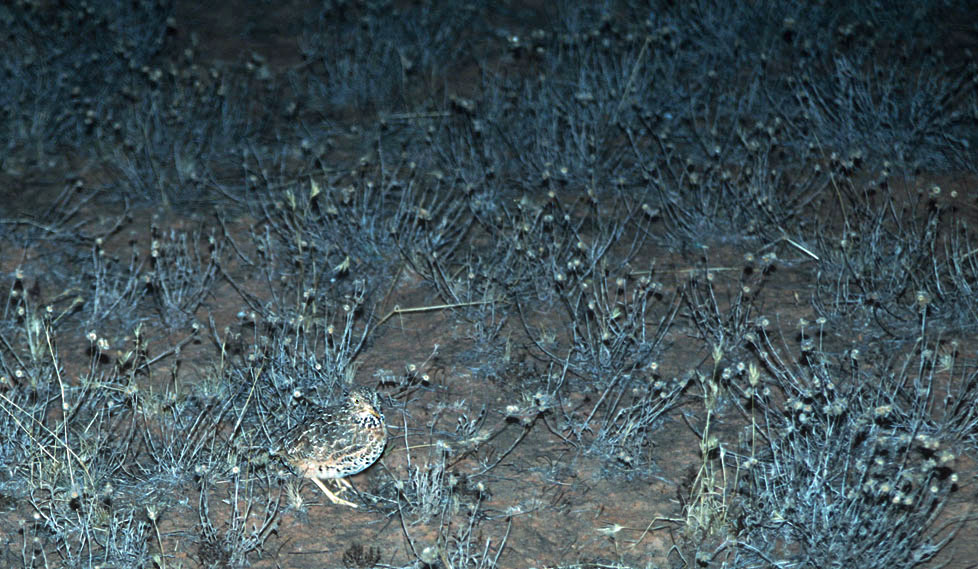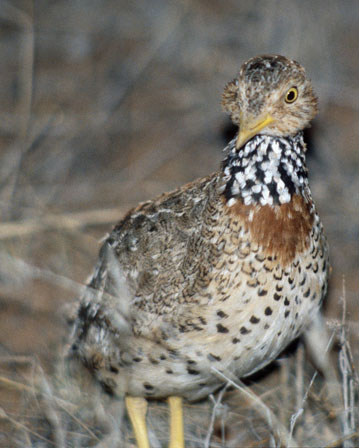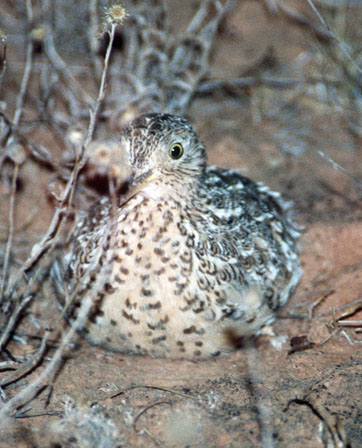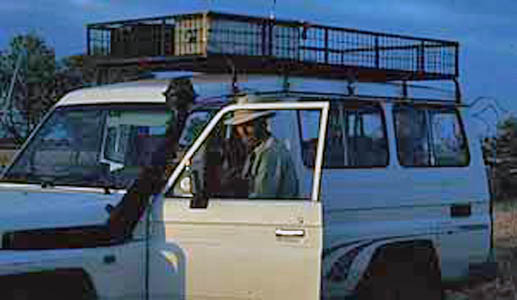
a web page by Don Roberson |
PLAINS-WANDERER Pedionomidae |
||
|
||
|
While there is a resemblance to buttonquails when the bird is crouching among the light cover on the barren plains it inhabits, it is a much stranger bird when standing up or running. It walks among the tussucks, occasionally stretching up to peer around for danger. That danger is much greater in the day when numerous raptors hunt the open plains and the birds are very shy; accordingly, most efforts to locate them are at night (as in these photos). The birds are very reluctant to fly, although they do disperse widely and unpredictably, flying like ponderous quail with legs trailing out behind (Baker-Gabb 1996). The Plains-wanderer has a polyandrous breeding system. Females contribute little to each nesting attempt before leaving to find their next mate. Like phalaropes, the female is larger and more brightly colored than the male. Here's a fine shot by Ed Harper of an adult female (below left0; compare to my photo of an adult male (below right). |
||
|
||
Traditionally, Plains-wander was often classified alongside the buttonquail (Turnicidae) in the order Gruiformes. Studies in anatomy and behavior (Olson & Steadman 1981, Livezey & Zusi 2007) showed that it actually is in the Charadriiformes (i.e., it is a shorebird, as are phalaropes). DNA-DNA hybridization research suggested a close relationship with the Seedsnipes of South America [Thinocoridae] (Sibley & Ahlquist 1990). Molecular research in this century place the Pedionomidae sister to Thinocoridae within a clade that also includes Painted-snipes [Rostratulidae] and Jaçanas [Jacanidae]; Fain & Houde (2007), Baker et al. (2007), Hackett et al. (2008), and Gibson & Baker (2012). All this suggests that the "an ancient member of Australia's avifauna" has origins "dating back to when Australia was part of the Gondwanan super-continent and connected to South America via the Antarctic land-bridge" (Baker-Gabb 1996). Plains-wandered is restricted to native grasslands, and it avoids altered habitats. This is a scarce and vulnerable species. In the 19990s, Baker-Gabb (1996) wrote that "Lowland native grasslands are among the most depleted ecosystems in eastern Australia, and threatened grassland fauna have undergone a marked decline. There are now possibly fewer than 11,000 Plains-wanderers left in the wild, and in drought years, when overgrazing of habitat occurs, the population may be halved." In this century, numbers continue to decline and it is now considered "critically endangered" with perhaps fewer that 7000 remaining. While habitat loss is the greatest threat, introduced foxes are also a problem. The Plains-wanderer is polyandrous. Nests are just a simple scrape in the ground, usually lined with grass. Females typically produce a clutch of four eggs. Incubation is mainly performed by males, although females may incubate on some occasions. Males provide all the post-hatching care. Chicks are precocial and leave the nest shortly after hatching, but remain with the adult male for about two months before becoming independent (Baker-Gabb 1988, 1996). |
||
Back in the 1990s, birders (including Rita and me) secured the services of Phil Maher to show them this rare and difficult species (right). Phil was a soft-spoken Aussie who lives up to one's expectations of those residing in the "outback." Maher makes his living leading birders, and the Plains-wanderer is a big part of his success. One engaged Maher for a day's birding and dinner on the hood of Phil's four-wheel drive landcruiser at dusk. Then one awaits the dark before venturing into the paddocks where the Plains-wanderer can be located. Numerous gates are opened and closed until one reaches the "right" type of shortgrass prairie on a large sheep ranch. Phil then slowly drives in ever-widening circles watching for one to run a short distance in his floodlight (below). Sometimes this happens quickly; at other times it takes hours. Phil explained that his banding studies show that, while the population is fairly sedentary, the individuals he finds from night to night are often quite different, thus living up to the name "wanderer." Phil is also careful to avoid harassing the same birds from night-to-night, and his efforts to show birders this weird and wonderful species has had no apparent impact on their well-being. Indeed, Maher has been a powerful voice for their preservation. |
||
 |
||
Photos: My photos of Plains-Wanderer Pedionomus torquatus were taken just before midnight on 31 Dec 1997 on private land, with permission and a guide, on the Riviere Plain, north of Conargo, New South Wales, Australia. I can think of few better ways to spend New Year's Eve. Ed Harper's photo of an adult female was taken there a few years later. All photos © Don Roberson;, except that attributed to W. Ed Harper, and used with permission; all rights reserved. Bibliographic note: There is no "family book" per se, but a fine introduction to this family, with some good photos, is in Baker-Gabb (1996). Literature cited:
|
 The Plains-wanderer is a small, unique bird of the open plains of south-eastern Australia. It is the sole representative of a family whose affinities were once uncertain. In the past, it was thought to be related to the buttonquails. They do look like a buttonquail when hunkered down on the ground. This female Plains-wanderer (left) has a collar of black-and-white, and a rusty blotch on the breast (not shown here) — it is a young female with fairly muted coloration.
The Plains-wanderer is a small, unique bird of the open plains of south-eastern Australia. It is the sole representative of a family whose affinities were once uncertain. In the past, it was thought to be related to the buttonquails. They do look like a buttonquail when hunkered down on the ground. This female Plains-wanderer (left) has a collar of black-and-white, and a rusty blotch on the breast (not shown here) — it is a young female with fairly muted coloration. 

 Seeing a Plains-Wanderer is an adventurous experience. They are actually diurnal and crepuscular birds (Baker-Gabb 1988) but because they are so shy in the day, most searches are done at night when the bird tends to run from the sound of a truck with a floodlight rather than crouch still as during daylight (presumably nocturnal predation pressure is much less). Before we had the chance to see this species in the wild, I had a very difficult time trying to figure out just what size it would be. In life, it was much smaller than I had expected, being perhaps the size of a Sora Porzana carolina or a baby chicken.
Seeing a Plains-Wanderer is an adventurous experience. They are actually diurnal and crepuscular birds (Baker-Gabb 1988) but because they are so shy in the day, most searches are done at night when the bird tends to run from the sound of a truck with a floodlight rather than crouch still as during daylight (presumably nocturnal predation pressure is much less). Before we had the chance to see this species in the wild, I had a very difficult time trying to figure out just what size it would be. In life, it was much smaller than I had expected, being perhaps the size of a Sora Porzana carolina or a baby chicken.